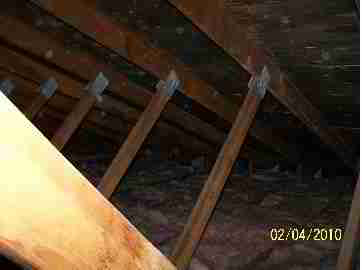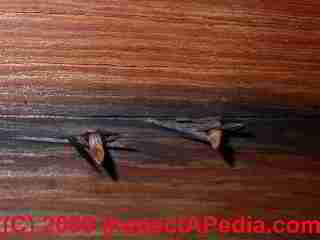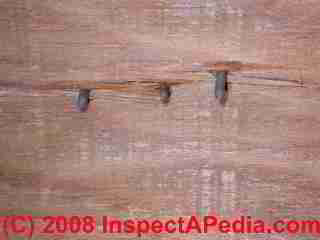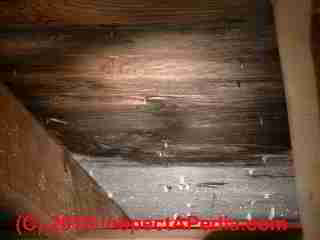 Causes of Mold in Attics
Causes of Mold in Attics
- POST a QUESTION or COMMENT about the underlying causes of mold in building attics
What causes mold contamination or growth in attics and cathedral ceilings?
Here we explain the causes of moldy attics or roof mold in buildings, and we discuss the relationship between other building moisture sources (such as a wet basement) and attic and roof mold contamination.
This document gives advice on how to find and deal with mold in building attics and roof cavities; We discuss when and how to clean up attic mold - how to get rid of attic or roof mold.
The page top photograph of dark mold found on the attic-side of plywood roof decking was contributed by David Grudzinski, a Cranston RI professional home inspector and member of ASHI and NACHI.
InspectAPedia tolerates no conflicts of interest. We have no relationship with advertisers, products, or services discussed at this website.
- Daniel Friedman, Publisher/Editor/Author - See WHO ARE WE?
Causes of Attic Mold Contamination
 What causes mold growth in attics? Understanding why we get mold contamination in roof spaces helps define the steps necessary to prevent attic mold, cathedral ceiling mold and similar problems.
What causes mold growth in attics? Understanding why we get mold contamination in roof spaces helps define the steps necessary to prevent attic mold, cathedral ceiling mold and similar problems.
As this moldy attic photo (courtesy of David Grudzinski) also shows, mold on roof decking or roof framing may be quite extensive.
If you look closely at the buckling plywood in the upper right of this photograph, you may notice some cracking that might indicate that the plywood roof decking is actually delaminating and badly damaged.
If that proves to be the case, this mold cleanup job will be simplified, but more costly as roof decking may need to be removed and replaced.
When we see an attic with extensive visible mold on wood surfaces, we also suspect that the fiberglass insulation may also be mold contaminated, or may become so during any mold cleanup job in the area.
See INSULATION MOLD CONTAMINATION TEST for details.
What Causes Attic Mold?
Cleaning up moldy wood surfaces, removing moldy attic insulation, will be a costly but wasted step if we don't understand and correct what caused these conditions in the first place.
Below we describe the combination of two critical factors that make for a wet, moldy attic: inadequate roof ventilation and an indoor source of un-wanted or excessive building moisture.
A third source, roof leaks, is more obvious and should also be considered in any building inspection for leaks, moisture, or mold.
Inadequate Roof Ventilation
David pointed out in his emailed comments that the attic of this home was not adequately vented. We don't see good, continuous intake ventilation at the house eaves or soffits (the lower roof edges.) We also did not see good roof exit venting along the ridge of the building.
Our example photos (below) show characteristic rust stains around roofing nails in a poorly-vented attic (below left), and the absence of those stains around roofing nails in a well-ventilated attic (below right). Even our poorly-vented attic (below left) was not as severely wet and moldy as the attic in Grudzinski's photos (above).


Our photo of frost on the under-side of an attic roof deck (left) shows another clue of inadequate under-roof ventilation that may be visible if the building is located in a freezing climate.
Regardless of its source, moisture entering the attic from anywhere is trapped in this space - contributing to mold growth and longer term to building rot or perhaps even inviting insect attack on the structure.
If the moisture levels were low, no mold problem may have occurred.
But if we combine poor roof ventilation with high moisture levels, we've asked for trouble with mold and rot.
Insulation improvements as well as attic ventilation improvements are discussed
at INSULATION INSPECTION & IMPROVEMENT, and
at ROOF VENTILATION SPECIFICATIONS we give specific details on good attic ventilation.
Indoor Moisture Sources Causing Attic Mold
 Poor insulation & bathroom, dryer, or kitchen fans not vented outside:
Poor insulation & bathroom, dryer, or kitchen fans not vented outside:
Mr. Grudzinski also observed that the moldy attic in this home was fed moisture from a combination of poor insulation, and two bath fans that were venting directly into the attic rather than being directed outside. "Poor insulation" means increased heat flow into the attic in cold weather.
Our photo (left, from a different home) shows a rats nest of bath vent fan ducts that the building owner emptied into a building attic. These vents should have been conducted to outside the building.
"Heat flow" into a cold attic means warm moisture-laden air flow from the occupied spaces in the home below is moving into the chilly or cold attic space. This airflow not only increases the cost of heating the home, but it brings up moisture from below into the attic area where water condenses out of the warm air onto cold attic surfaces.
Wet basements or crawl spaces mean wet moldy attics:
At BASEMENT MOLD WATER IMPACT another series of photographs by Mr. Grudzinski demonstrates how a wet (rotting, moldy) sub-basement served as a moisture source that was almost certainly a major contributor to if not the main cause of the moldy attic shown in our page top photographs here.
At ATTIC CONDENSATION CAUSE & CURE and
at ROOF ICE DAM LEAKS we describe problems caused by inadequate roof ventilation that include not just attic moisture and mold, but ice damming and even leaks into building ceilings and walls.
Also see our photo guide to finding attic moisture and mold
at HOW to INSPECT ATTICS for CONDENSATION or MOISTURE - to Detect & Correct Attic Condensation, Frost, Ice Dam Leaks & Attic Mold
 Toxic attic mold: The photo at the left was identified as a toxic mold that probably should be removed. Lots of protruding nails through a roof deck preclude wiping or scrubbing.
Toxic attic mold: The photo at the left was identified as a toxic mold that probably should be removed. Lots of protruding nails through a roof deck preclude wiping or scrubbing.
Mold growth, provided it is not just cosmetic mold which can simply be left alone, can be cleaned from wood surfaces by blasting, scrubbing, or even simple surface wiping, depending on the surface accessibility and smoothness.
See details at COMETIC MOLD
Sanding wood building surfaces such as plywood or tongue and groove roof sheathing, wall sheathing, or wood framing is usually unnecessary and inappropriate.
If you must return wood surfaces to immaculate, pristine looking condition, perhaps for cosmetic reasons where wood surfaces are left exposed to view in a building interior,
Procedures for total cleaning / restoration of mold-contaminated wood surfaces
- MOLD CLEANUP by MEDIA BLASTING
- MOLD CLEANUP with BLEACH
- MOLD CLEANUP - WOOD FRAMING & PLYWOOD
- MOLD CLEANUP HEALTH RISKS
Question: can a basement flood or wet crawl space cause attic mold contamination?
My mother's home has mold in the attic and I am wondering if the mold could be caused by two floods she had in her basement.
The first caused extensive mold damage in the basement. Could you please advise. - G.D. 7/30/2013 /P>
Reply:
Yes basement flooding can contribute to or even be the primary cause of an attic mold problem. In most buildings moisture moves upwards through the building naturally on rising warm-air convection currents, from basement or crawl space up to the attic or other under-roof space like a cathedral ceiling. Most of that air and moisture movement is through various openings or penetrations that may be visible in the living area (openings around a ceiling light fixture for example) or hidden within building wall cavities (openings around wiring or pipes for example).
See details: AIR BYPASS LEAKS, THERMAL TRACKING
Combining a wet basement with poor attic ventilation makes attic mold still more likely.
See details ATTIC CONDENSATION CAUSE & CURE
When I make a field investigation of a building that has an upper floor or attic mold problem I inspect the entire property, inside and out, to identify both construction methods/materials and actual leak evidence as sources of water or moisture indoors. That always includes a look at the basement: even if we know there is a moisture problem in the attic. We need to know if the wet attic conditions are due to a roof leak, ventilation defects, or an in-building moisture source such as a wet basement or crawl space.
Why doesn't the basement or crawl space moisture also cause mold contamination on lower building floors?
Well it can; but consider also that speaking generally, as individual building details vary widey, moisture moves upwards through the building to accumulate in areas where it is trapped. If warm moist air is not trapped until it reaches a poorly-vented attic, then that's where it may be most noticed.
Also see
HUMIDITY LEVEL TARGET - how dry does the building interior need to be
Question:
(Feb 26, 2012) sue white said:
I know someone who is leaving an attic access open with windows on 1st and 2nd floor open during mild weather to alow for breezes into house.
There is no central a/c. now there is mold in the attic. can this be due to moisture laden air being pulled into attic and inadequate ventilation resuliting in mold on sheathing. some roor trusses and contents also have mold
Reply:
Possibly yes, though we'd need to understand more about the building, the extent of under-roof ventilation, and air movement through the structure.
...
Continue reading at ATTIC MOLD IS A PROBLEM ? or select a topic from the closely-related articles below, or see the complete ARTICLE INDEX.
Or see these
Recommended Articles
- ATTIC MOLD - home
- ATTIC MOLD CAUSES
- ATTIC MOLD IS A PROBLEM ?
- ATTIC MOLD - IS IT TOXIC?
- ATTIC MOLD, WHERE TO LOOK
- ATTIC MOLD, WHAT IT LOOKS LIKE
- ATTIC MOLD, HARMLESS COSMETIC?
- ATTIC MOLD ROOF TEAROFF
- ATTIC MOLD ENCAPSULANTS
- INSULATION MOLD CONTAMINATION TEST
- MOLD APPEARANCE - WHAT MOLD LOOKS LIKE
Suggested citation for this web page
ATTIC MOLD CAUSES at InspectApedia.com - online encyclopedia of building & environmental inspection, testing, diagnosis, repair, & problem prevention advice.
Or see this
INDEX to RELATED ARTICLES: ARTICLE INDEX to MOLD CONTAMINATION & REMEDIATION
Or use the SEARCH BOX found below to Ask a Question or Search InspectApedia
Ask a Question or Search InspectApedia
Try the search box just below, or if you prefer, post a question or comment in the Comments box below and we will respond promptly.
Search the InspectApedia website
Note: appearance of your Comment below may be delayed: if your comment contains an image, photograph, web link, or text that looks to the software as if it might be a web link, your posting will appear after it has been approved by a moderator. Apologies for the delay.
Only one image can be added per comment but you can post as many comments, and therefore images, as you like.
You will not receive a notification when a response to your question has been posted.
Please bookmark this page to make it easy for you to check back for our response.
IF above you see "Comment Form is loading comments..." then COMMENT BOX - countable.ca / bawkbox.com IS NOT WORKING.
In any case you are welcome to send an email directly to us at InspectApedia.com at editor@inspectApedia.com
We'll reply to you directly. Please help us help you by noting, in your email, the URL of the InspectApedia page where you wanted to comment.
Citations & References
In addition to any citations in the article above, a full list is available on request.
- David Grudzinski, Advantage Home Inspections, ASHI cert # 249089, HUD cert# H-145, is a professional home inspector who contributes on various topics including structural matters. Mr. Grudzinski, Cranston RI serving both Rhode Island and Eastern Connecticut can be reached at 401-935-6547 fax- 401-490-0607 or by email to Davidgrudzinski@aol.com. Mr. Grudzinski is a regular contributor to InspectAPedia.com
- In addition to citations & references found in this article, see the research citations given at the end of the related articles found at our suggested
CONTINUE READING or RECOMMENDED ARTICLES.
- Carson, Dunlop & Associates Ltd., 120 Carlton Street Suite 407, Toronto ON M5A 4K2. Tel: (416) 964-9415 1-800-268-7070 Email: info@carsondunlop.com. Alan Carson is a past president of ASHI, the American Society of Home Inspectors.
Thanks to Alan Carson and Bob Dunlop, for permission for InspectAPedia to use text excerpts from The HOME REFERENCE BOOK - the Encyclopedia of Homes and to use illustrations from The ILLUSTRATED HOME .
Carson Dunlop Associates provides extensive home inspection education and report writing material. In gratitude we provide links to tsome Carson Dunlop Associates products and services.


